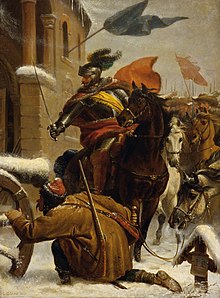
Back Schlacht bei Tuttlingen German Batalla de Tuttlingen Spanish Bataille de Tuttlingen French קרב טוטלינגן (1643) HE Battaglia di Tuttlingen Italian トゥットリンゲンの戦い Japanese Bitwa pod Tuttlingen Polish Битва при Тутлингене Russian
| Battle of Tuttlingen | |||||||
|---|---|---|---|---|---|---|---|
| Part of the Thirty Years' War and the Franco-Spanish War (1635–59) | |||||||
 Johann de Werth's Überfall bei Tuttlingen by Karl von Blaas (oil on canvas, 1866) | |||||||
| |||||||
| Belligerents | |||||||
|
Holy Roman Empire Electorate of Bavaria Spain | Kingdom of France | ||||||
| Commanders and leaders | |||||||
|
Franz von Mercy Johann von Werth Juan de Vivero | Josias Rantzau (POW) | ||||||
| Strength | |||||||
| 15,000[1]–22,000[2] |
15,000[1]–18,000[2] 10 guns | ||||||
| Casualties and losses | |||||||
| 1,000[2] |
7,000[2]–10,500[1] 10 guns | ||||||
The Battle of Tuttlingen was fought in Tuttlingen on 24 November 1643 between the French army in Germany led by Marshal Josias Rantzau, composed of French soldiers and the so called Weimarans or Bernhardines, German troops once in service of Bernard of Saxe-Weimar. They were defeated by the forces of the Holy Roman Empire, Bavaria and Spain led by Franz von Mercy. Technically, Mercy led a military force composed of his Bavarian army, supported by Imperial, Spanish, and Lorrainer troops. The French army was wiped out in a surprise attack in heavy snowfall along with French strategic gains since 1638. The French court suppressed the defeat and it remains largely unknown today, even among historians of the war.
- ^ a b c Wilson 2009, pp. 642–643.
- ^ a b c d Bodart 1908, p. 71.